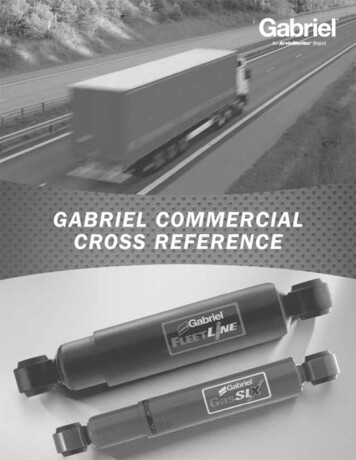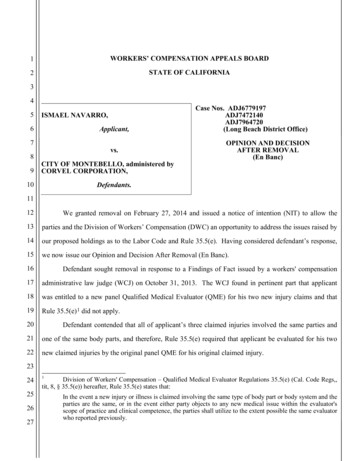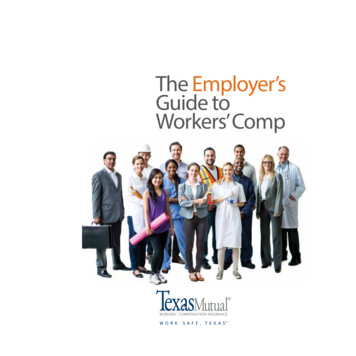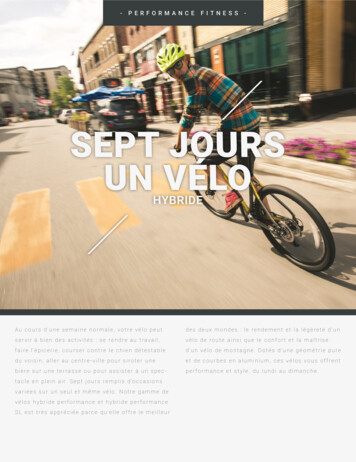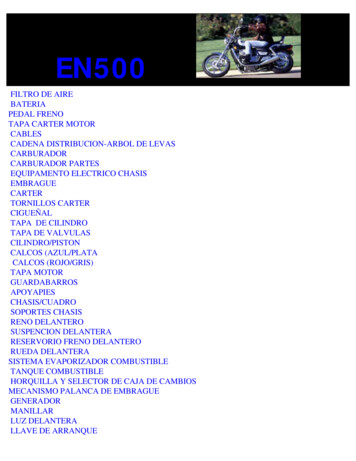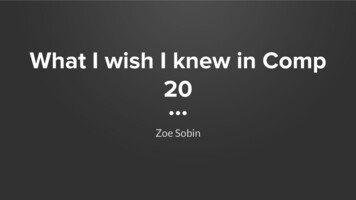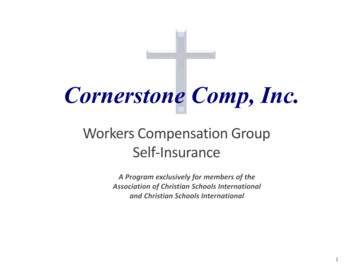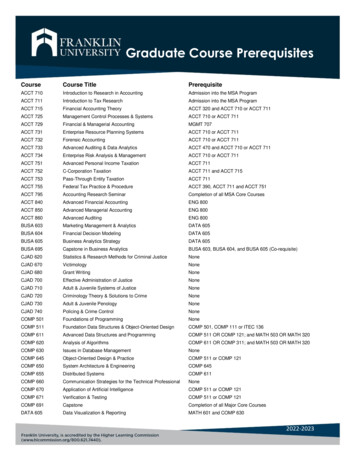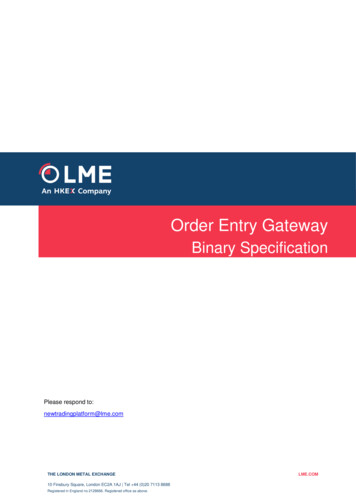
Transcription
BUSINESS SIMULATIONSE X A M I N AT I O NUSA & Canada877.477.8787Outside USA & Canada 1.312.477.7200WWW.CAPSIM.COM
Welcome to Comp-XMYour Registration NumberWelcome to Comp-XM , an integrated evaluation tool that will allowyou to demonstrate your business skills. Comp-XM has two sections:1. A business simulation similar to the one you just completed and2. A series of quizzes, called Board Queries, that ask questionsrelated to your simulation environment.If your instructor or school did not give you aRegistration Number, you will need to registeronline using a credit card or checking account.The SimulationBoard QueriesRound 1You are the CEO of a new company, theAndrews Corporation. You will make foursets of decisions. Your competition, Baldwin,Chester and Digby, are run by computers. all participants go up against a standardset of competitors. As with your previoussimulation, the quality of your decisionsdirectly affects the position of your company.Performance is evaluated using a BalancedScorecard, an analysis technique that gaugesresults across four areas. ! Round 2Round 3Round 4FinalBoard Queries are web-based quizzes that relatedirectly to the results of your simulation. As CEO, youwill report to the Board of Directors. The Board " # % & % that are based on the results of your previous rounds. ' % ( a break-even analysis on an increase in productionautomation or calculate the effect additional( ! ! ) questions use standard true-false, multiple choiceand essay formats.All the information needed to answer the queriesappears within the pages of The Comp-XM Inquirer,an industry newsletter similar to The Capstone ") * / you work as an individual, which means all successwill be attributed to your efforts. This is your chanceto show your strategic vision, tactical abilities andbusiness knowledge. Best of luck!Table of Contents1 Introduction . 1. 52 Scoring . 24.1 Market Segments. 52.1 Board Queries . 24.2 Growth Rates. 62.2 Balanced Scorecard . 24.3 Rough Cut / Fine Cut. 6. 24.4 Seller’s Market . 83.1 Research & Development . 25 Reports . 83.2 Marketing . 36 Website Instructions. 83.3 Production. 36.1 The Comp-XM Spreadsheet. 83.4 Finance. 36.2 Dashboard. 8. 36.3 Answering Board Queries . 93.6 Human Resources Entries . 46.4 Round Schedules. 93.7 TQM/Sustainability . 46.5 Self-Paced Exams. 10.3 Decision Summaries.3.5 Human Resources4.4 Industry Conditions Report.
Differences From Your Previous Simulation1 IntroductionYou have just been recruited to head the Andrews Corporation’snewest spin-off, the Andrews Comp-XM Corporation. The unitconcentrates Andrews’ biometric sensor efforts into a new, publiclytraded company.1.1 What Is Comp-XM?Comp-XM is familiar, yet different from your experience in Capstoneor Foundation. You are the CEO. You will be making decisions onyour own; you will not be a member of a team. Like Capstone orFoundation, Comp-XM uses a spreadsheet and a web interface.“6 Website Instructions” discusses the mechanics.There are two parts to Comp-XM: A four-round simulation, and aseries of web-based quizzes called Board Queries. Board Queries arequestions posed by your Board of Directors. They are drawn from theunique results of your simulation. You could appear before the Boardup to five times to answer their questions about your company.decisions will be required (Table 1.1). Decisions and Board Queriesrequire the Comp-XM Inquirer.Table 1.1 Standard Comp-XM ScheduleRoundActivitiesMaterial Needed1Round 1 DecisionsBoard Query 1Round 0 Comp-XM Inquirer2Round 2 DecisionsBoard Query 2Round 1 Comp-XM Inquirer3Round 3 DecisionsBoard Query 3Round 2 Comp-XM Inquirer4Round 4 DecisionsBoard Query 4Round 3 Comp-XM InquirerFinalNo DecisionsFinal Board QueryRound 4 Comp-XM InquirerYour instructor can configure Comp-XM to have fewerBoard Queries.Comp-XM Inquirer and Industry ConditionsAll the information needed to answer the questions appears withinthe pages of The Comp-XM Inquirer, an industry newsletter that issimilar to The Capstone Courier or The Foundation FastTrack.“4 Industry Conditions Report” summarizes the current state of thebiometric market.1.2 WorkflowComp-XM has four decision rounds. Each round, you will enter a setof decisions via the Comp-XM Spreadsheet.In the standard Comp-XM setup, each round you will also answer theBoard Queries posed by the board of directors. At the end of thesimulation, you will answer a fi fth set of Board Queries, but noFigure 1.1 Segment Positions at the Endof Round 0 and the Beginning of Round 11.3 Differences From YourPrevious SimulationComp-XM has four market segments: Thrift Core Nano EliteComp-XM TQM (Total Quality Management)/Sustainability andHuman Resources Modules are active in Round 1.The segment circles start the simulation in the middle of thePerceptual Map before drifting to the lower right (Figures 1.1 - 1.3).Figure 1.2 Segment Positions at the Endof Round 2 and the Beginning of Round 3Figure 1.3 Segment Positions at the Endof Round 41
Board Queries2 Scoring3 Decision SummariesScoring occurs in two parts, the results of your Board Queries, andthe results of your simulation, which are assessed via a BalancedScorecard.Decision entries are made with the Comp-XM Spreadsheet, which issimilar to the Capstone Spreadsheet and the Foundation Spreadsheet.Please refer to your Capstone or Foundation Team Member Guide forgeneral information.Comp-XM has 1000 possible points, 500 for your Board Query resultsand 500 for your Balanced Scorecard.2.1 Board QueriesBoard Queries are unique to each participant, although eachquestion covers the same content. If a question applies to aproduct, the question might be posed about any of the productsin the simulation.Each simulation generates different numbers, so each questioncontaining numbers varies by participant. Furthermore,product names and competitor assignments vary from participantto participant.All Comp-XM simulations utilize the Human Resources and TQM(Total Quality Management)/Sustainability modules. Decisions madein these modules can have wide ranging effects, including influencingproduct demand, R&D cycle times, productivity, material costs, laborcosts and administrative costs.TQM and Human Resource drive the Learning and Growth section ofthe Balanced Scorecard.Human Resources decisions are made in two locations: The Workforce Complement is entered at the bottom of theProduction area; Recruit Spend and Training decisions are made in theHuman Resources area.Here’s an example of a Comp-XM Board Query: You are askedto find the Net Margin for product Biff. Your classmate isAll TQM/Sustainability decisions are made in the TQM/Sustainability area.asked to find the Net Margin for product Bold.Both questions have the same level of difficulty, but theanswers are based on different numbers.2.2 Balanced ScorecardComp-XM uses a Balanced Scorecard for simulation scoring. ABalanced Scorecard is a common analysis technique that allowscompanies to gauge their current performance and formulate futuregoals. Balanced Scorecards are divided into four areas:3.1 Research & Development3.1.1 Positioning CostsMaterial costs are also driven by positioning (Figure 3.1). The higherthe technology, the higher the cost. At the beginning of thesimulation, the trailing edge of the Thrift segment has the lowest cost,at 1.00; the leading edge of the Nano and Elite segments have the Financial Internal Business Process Customer Learning and GrowthEach Comp-XM Scorecard is built from criteria which are assigned aweight– a level of importance. Criteria, weights and results for eachround, and criteria, weights and results for a final overall scorecard,are available from the Dashboard.As you enter decisions in the Comp-XM Spreadsheet, projections ofthe Balanced Scorecard results for the upcoming year are availablevia the proforma menu. Scores from previous years are available onthe website; login to your simulation then click the Results/Scorecards link.2Figure 3.1 Material Positioning Costs: These costs vary depending on the product’s relative location on the perceptual map. Forexample, at the start of Round 1, products placed at the trailingedge of the Thrift segment would have a positioning componentcost of 1.00; products placed at the leading edge of the two hightechnology segments would have a positioning component cost of 9.25. Material component costs drop 3% to 4% per year.
Human Resourceshighest costs, at 9.25. Positioning material costs decrease 3% to 4%per year.Comp-XM uses a straight line depreciation method calculatedover fifteen years.3.1.2 MTBF (Mean Time Before Failure)Each 1,000 hours of reliability (MTBF) adds 0.30 to the materialcost. A product with 20,000 hours reliability includes 0.30 *20,000/1000 6.00 in reliability costs.3.2 Marketing3.2.1 Promotion BudgetPromotion expenditures reach diminishing returns at 3,000,000 foreach product. Promotion buys awareness. You lose one third of yourold awareness each year. Your promotion budget replaces lostawareness, and if the budget is high enough, makes gains towards100% awareness. When a product reaches 100% awareness,promotion budgets of about 1,400,000 are needed to maintain it.3.3.3 Second Shift/OvertimeLabor costs increase 50% when a second shift is hired or when thefirst shift works overtime.3.3.4 AutomationIncreasing automation has a linear effect on labor costs. Between anautomation of 1.0 (lowest) to 10.0 (highest), labor costs fallapproximately 10% for each point of automation.3.4 Finance3.4.1 StockStock issues are limited to 20% of the company’s outstanding shares.You pay a 5% brokerage fee to issue stock.3.2.2 Sales BudgetSales budgets buy segment accessibility. Although you budget byproduct, any product within the segment’s fine cut contributes toaccessibility. Diminishing returns are reached at a budget of 3,000,000 for each product. Diminishing returns in the segment,however, are not reached until 4,500,000. You need at least twoproducts in the segment’s fine cut to reach 100% accessibility. Youlose one third of your old accessibility each year. Your sales budgetsreplace lost accessibility, and if the budgets are high enough, makegains towards 100% accessibility. When a segment reaches 100%accessibility, sales budgets of about 3,300,000 are needed tomaintain it.Sales budgets also allocate the time spent by the sales force sellingthe product. The higher the budget, the more time the sales forcegives to the product. This can be useful if you wish to emphasize oneproduct over another within the same segment. For example, if youare splitting a combined 4,000,000 sales budget between twoproducts, you might spend 3,000,000 with one and 1,000,000with the other. Your salespeople would emphasize one product overthe other.3.4.2 Current DebtThese are one year bank notes. Bankers will loan current debt up toabout 75% of your accounts receivable (found on last year’s balancesheet) and 50% of this year’s inventory. They estimate your inventoryfor the upcoming year by examining last year’s income statement.Bankers assume your worst case scenario will leave a three to fourmonth inventory, and they will loan you up to 50% of that amount.This works out to be about 15% of the combined value of last year’stotal direct labor and total direct material, which display on theincome statement.There is no brokerage fee for current debt.3.4.3 BondsThese 10 year notes carry an interest rate 1.4% higher than thecurrent debt rate in the year they were issued. Bondholders arewilling to lend amounts up to 80% of the depreciated value of thecompany’s plant and equipment, that is, the assembly lines. You pay a5% brokerage fee to issue bonds.Companies with better Bond Ratings have lower3.3 Production3.3.1 Plant PurchasesFloor space for each unit of capacity is 6.00. Add 4.00 for eachpoint of automation. Additional capacity at an automation rating of10.0 would cost 6.00 ( 4.00 * 10.0) 46.00 per unit.interest rates.If your company runs out of cash, you will receive anemergency loan, which carries a 7.5% penalty above theCurrent Debt interest rate. Emergency loans convert toCurrent Debt in the following year.3.3.2 Plant SalesWhen you sell plant, you get 0.65 on each original dollar. Dependingon the depreciated value of the plant, you could make a gain or a losson the sale which will appear as a gain or loss on the incomestatement.3.5 Human Resources3.5.1 RecruitingInvesting in recruiting a better quality employee increasesproductivity and decreases turnover, which will reduce your labor3
Human Resources Entriesand HR Admin costs. The effect of investing in recruitment iscumulative. You can spend up to 5,000 per person to hire bettertalent. The amount is added to the automatic recruitment charge of 1,000 for every new employee.3.5.2 TrainingInvesting in training also increases productivity and decreasesturnover. Each year, you can assign up to 80 hours of training peremployee, which increases productivity. Each training hour costs 20.00. When employees are in training they are replaced with otheremployees, so the Needed Complement will increase as traininghours increase. The effect of investing in training is cumulative.3.6 Human Resources EntriesWorkforce Complement entries are made in the Production area.Workforce Complement controls the number of workers employed bythe company. Once production schedules are complete, thespreadsheet will display a Needed Complement. Matching theWorkforce Complement to the Needed Complement ensures thecompany will have sufficient workers.Having more workers than needed drives up labor costs as workersstand around doing nothing. Having fewer workers than neededresults in worker overtime, which cuts into the efficiency of theworkforce. Having significantly fewer workers than necessary willresult in serious production shortfalls because labor will not beavailable to manufacture the sensors.Always review the Workforce Complement entry at thebottom of the Production area after making changes to theProduction Schedule, Training Hours or TQM/Sustainabilityinitiatives. Serious financial consequences can result if theWorkforce Complement is too low or too high.Recruit Spend and Training Hour entries are made in the HumanResources area.Recruit Spend allows the company to attract a higher caliber worker,which will increase the efficiency of the workforce as measured bythe Productivity Index.Training Hours will also increase efficiency. However Training Hoursincrease the Needed Complement because workers are in theclassroom, not on the production lines.Investments in Recruiting and Training raise your Productivity Index,which in turn lowers your per unit labor costs. Scheduling overtimereduces any gains to the Productivity Index. The Productivity Indexcannot go below 100%. Refer to the red flags on the Production andHuman Resources spreadsheets, which activate pop-up explanationwindows, for a thorough discussion of Human Resources entries.3.7 TQM/SustainabilityThe TQM (Total Quality Management)/Sustainability Module allowscompanies to invest in several initiatives. Different initiatives returndifferent benefits. For example, some initiatives will reduce labor andmaterial costs, others will reduce R&D cycle time (allowing you tore-engineer products faster), and others will increase productappeal or decrease administration costs. You don’t have to investin all initiatives.Differentiators might want to reduce R&D cycle times, to ensure theirproducts are newer and better positioned. Cost leaders might want toreduce material and labor costs, allowing them to reduce priceswhile maintaining their margins.The return on investment follows an S-curve (Figure 3.2). If youspend too little or too much the returns on your investment are poor.If you spend less than 500,000 in any initiative in a single roundchances are you will see little return. An investment of 1,500,000 ina single roundproduces acost-effectiveimpact,investments over 1,500,000become dollar fordollar lesseffective. Finally,for each initiative,an investment over 2,000,000 in asingle roundproducesFigure 3.2 S-Shaped Curveabsolutely noadditional benefit.For each impact, complementary initiatives combine together toincrease the total effect. You should bundle your investments inmultiple initiatives that have an impact important to your company’sstrategy. By spreading your investment among complementaryinitiatives you can invest more in each impact than the limit of 2,000,000 for an individual initiative. For example, to reducematerial costs, companies should consider investing in both CPISystems and GEMI TQEM Sustainability.Aggressive spending in each initiative would involve spending 1,500,000 in year 1, 1,500,000 in year 2, and 1,000,000 in year 3.The Best Case/Worst case table gives an indication of the return oninvestment. The impact is cumulative so cost reductions will continuein future years.Refer to the flags on the TQM/Sustainability spreadsheet for athorough discussion of TQM/Sustainability entries.4
Market Segments4 Industry Conditions ReportIn the next four years, the biometric sensor market will see a 59%increase in unit demand. Growth rates vary among the four marketsegments – Thrift, Core, Nano, and Elite.The biometric sensor industry is a fast growing sector of the largersensor industry:Thrift Segment CriteriaThrift customers seek proven products, are indifferent totechnological sophistication and are price motivated: Price, 14.00- 26.00– importance: 55% MTBF, 14,000-20,000– importance: 20% Ideal Position at the end of Round 0,performance 6.5 size 13.5– importance: 15% Age, 3 years– importance: 10% Andrews Comp-XM Corporation has three competitors, biometric business units of Baldwin, Chester, and DigbyCorporations– these companies have well establishedstrategic directions;There are four segments;There are no labor unions but there are opportunities toinvest in Human Resources;Some companies have been investing in TQM (Total QualityManagement)/Sustainability.As CEO you will be responsible for the strategic direction of theAndrews Comp-XM business unit and its tactical execution.At the beginning of every year, the board of directors will ask you torespond to a set of questions about your situation. The questions willbe drawn from recent activities within the industry as described inlast year’s results and from the situation that you expect to developover the next year.After satisfying the board’s questions, you will execute your plan bymaking operational decisions in Research & Development (R&D),Marketing, Production, Human Resources, TQM/Sustainability andFinance. Your results will be assessed with a Balanced Scorecard.Age 10%MTBF 20%Price 55%Positioning 15%Figure 4.1 Thrift Segment Buying CriteriaCore Segment CriteriaCore customers seek proven products using current technology: Price, 20.00- 32.00– importance: 46% Age, 2 years– importance: 20% MTBF, 16,000-22,000– importance: 18% Ideal Position at the end of Round 0,performance 8.6 size 11.4– importance: 16%Age 20%Price 46%MTBF 18%4.1 Market SegmentsThe biometric sensor market evolved from two original markets, alow technology segment and a high technology segment. The originallow tech segment split into Thrift and Core. The original high techsegment split into Nano and Elite. Because of this evolution, thesegments are less distinct than the segments in your former business.Straddling two segments with a product is still viable, although youcan expect straddling to become more difficult as the market evolves(see Figures 1.1 - 1.3).Each market segment expects different: Positioning Age Price MTBF (Mean Time Before Failure)Positioning 16%Figure 4.2 Core Segment Buying CriteriaNano Segment CriteriaNano customers seek cutting-edge technology that is small in size: Ideal Position at the end of Round 0,performance 10.5 size 7.5– importance: 35% Price, 28.00- 40.00– importance: 27% Age, 1 year– importance: 20% MTBF, 18,000-24,000– importance: 18%Price 27%Age 20%MTBF 18%Price, Age and MTBF ranges for each segment hold steadyyear after year. Positioning expectations advance steadilyevery month.Positioning 35%Figure 4.3 Nano Segment Buying Criteria5
Growth Rates4.3 Rough Cut / Fine CutElite Segment CriteriaElite customers seek high reliability and cutting edgeperformance technology:Positioning Price, and Reliability work the same as they did at yourlast company. The segments drift every year. Rough cut and fine cutcriteria still hold true for the Comp-XM industry. Your productdesigns must meet at least the rough cut criteria before earning sales. Age, 0 years– importance: 34% Price, 30.00- 42.00– importance: 24% Ideal Position at the end of Round 0,performance 12.5 size 9.5– importance: 22%4.3.1 Segment Locations MTBF, 20,000-26,000– importance: 20%Price 24%As is in the larger sensor industry, the market segments in theComp-XM industry move to the lower right. The outer rough cutcircles measure 4.0 units; the inner fine cut circles measure 2.5 units.The segment centers for each round are listed in Table 4.3.Age 34%Table 4.3 Segment Centers At The End Of Each RoundPositioning22%MTBF 20%ThriftFigure 4.4 Elite Segment Buying CriteriaCoordinatesRd 0Rd 1Rd 2Rd 3Rd 13.614.715.8Size10.39.58.77.97.1SizePerformance4.2 Growth RatesCoreGrowth rates differ among the segments. Thrift and Core are growingat a slower pace, 11.0% and 10.0%, than Nano and Elite, 14.0% and16.0% (Figure 4.5).NanoEliteSize4.3.2 PriceFigure 4.5 Yearly Increase In Unit DemandIn the next four years, Thrift’s and Core’s percentage of the overallmarket will decline. Today, the number of units sold to the Nanosegment is greater than those sold to the Elite segment (Table 4.1).Table 4.1 Last Year’s Unit DemandTable 4.4 Segment Price RangesMinimumMaximumThrift 14.00 26.00ThriftCoreNanoEliteCore 20.00 32.0027.0%35.3%19.3%18.4%Nano 28.00 40.00Elite 30.00 42.00However, in four years, Elite’s unit sales will exceed Nano’s(Table 4.2).Table 4.2 Unit Demand Four Years From Now6Price ranges in each segment have held steady for the past four yearsand will continue to do so for the next four years (Table 4.4).Customers want the price of their product to lie within the expectedrange. As the price moves outside the expected range, demand for theproduct begins to fall. For each dollar outside the range, demandfalls 16.7%. When price reaches 6.00 outside the range, demandreaches zero.ThriftCoreNanoElite25.8%32.6%20.6%21.0%
Rough Cut / Fine Cut4.3.3 MTBF (Mean Time Before Failure)4.3.4 AgeCustomers want reliability or MTBF to be within the ranges in Table4.5. Within the range, the higher the reliability, the higher thedemand. However, above the range customers are content and awardno additional demand.Customer age assessments vary from segment to segment, as shownin Figure 4.6. All other factors held constant, demand is highest whenthe age is at the ideal. For example, Core customers prefer productsthat are 2 years old.As the MTBF moves below minimum expectations, the product losesdemand. For every 1,000 hours below the range, demand drops by16.7%. At 6000 hours below the range, demand falls to zero.Table 4.5 Segment MTBF ,000Nano18,00024,000Elite20,00026,000Customers are indifferent to products with MTBFs above4.3.5 Ideal SpotsFor each segment, customers prefer products placed near the idealspot, which is a position relative to the segment center (Table 4.6 andFigure 4.7).Table 4.6 Segment Ideal Spot OffsetsPerformanceSizeThrift0.00.0Core 0.4-0.4Nano 0.8-1.1Elite 1.1-0.8the guideline.Figure 4.6 Preferred Ages: Thrift and Core customers seek out proven technology. Thrift prefers products in the three year range and Core in the twoyear range. Nano and Elite customers demand the latest technology. Nano prefers products in the one year range and Elite wants cutting edge, brandnew products.Figure 4.7 Customers prefer products located in the darker areas. The darkest areas indicate the ideal spots. The inner fine cut circleshave a radius of 2.5 units, the outer rough cut circles have a radius of 4.0 units. Thrift customers prefer products located in the center ofthe circle. Core customers prefer products located to the lower right of the circle center. Nano customers want products near the lowerright edge of the circle, preferring smaller size over faster performance. Elite customers want products near the lower right edge of thecircle, preferring faster performance over smaller size.7
Seller’s Market4.4 Seller’s MarketIn a Seller’s Market, all the good products in a segment stock out.Desperate customers turn their attention to the remainingundesirable products (which may even target another segment), aslong as they are within the rough cuts for price, MTBF andpositioning.The Inquirer is different from The Capstone Courier and TheFoundation FastTrack! Please be sure to use the Inquirer asyou work on Comp-XM.The Inquirer is available prior to and while working on your rounddecisions and while answering Board Queries.Product sales are driven by the monthly Customer Survey Score (theDecember score is published in The Comp-XM Inquirer segmentanalysis pages). Any product with a score of 1 or more competes forsales– the higher the score, the higher the appeal. As a productapproaches any of the rough cuts, its score falls towards 0.Usually a product with very low appeal makes few sales. However, in aSeller’s Market, customers will accept marginal products as long asthey fall within the rough cut limits. For example, desperatecustomers with no better alternatives will buy: A product priced 5.99 above the price range– at 6.00 customers reach their tolerance limit and refuse to buy theproduct;A product with MTBF 5,999 hours below the range– at 6,000hours below the range customers refuse to buy the product;A product positioned just inside the rough cut circle on theperceptual map– outside the circle they say “no” tothe product.6 Website InstructionsLogin to the website with the User ID andPassword from your previous simulation.Select Comp-XM (Figure 6.1).Figure 6.1In the Getting Started area, view the briefintroductory video in the Welcomesection. Be sure to review the Sample Board Query in the AboutBoard Queries section. Go through the remaining sections.6.1 The Comp-XM SpreadsheetIn the Getting Set Up section, download the Comp-XM Spreadsheet toyour computer (a web version of the spreadsheet is available from theDashboard, see below). You will open the Comp-XM Spreadsheet as you did the5 ReportsCapstone or Foundation Spreadsheet; Enter the same User ID and Password you used to login tothe website;Customer purchase and sensor company financial results arereported in an industry newsletter, The Comp-XM Inquirer. TheInquirer has three notable differences from your previousindustry report: You can only view the most recent Inquirer ; Your company’s annual report is accessed from the Inquirer; You now have access to your competitors’ annual reports.The Inquirer is available from two locations: From the Comp-XM Dashboard, click the Comp-XM Inquirerlink (see “6.2 Dashboard”); From the Comp-XM Spreadsheet, click the Reports link in themenu bar.8 The Comp-XM Spreadsheet requires an Internet connection–it retrieves your work from the website when it opens andsends your work to the website when you save decisions.Use your User ID and Password from your Capstone orFoundation simulation to login to the Comp-XM Spreadsheet.6.2 DashboardWhen you complete the Getting Started introduction, the system willbring you to the Exam Dashboard, an area where activities andinformation are accessed, including Board Queries and the webversion of the Comp-XM Spreadsheet.
Round Schedules6.3 Answering Board QueriesEach round, your Board of Directors presents you with a set ofquestions. You can answer these questions before, during, or afteryou make decisions for your company (we recommend before): From the Dashboard, click the Answer Board Query button; A new window opens asking you to authenticate that you are the person taking the exam– click I Agree;Next, a list of Board Query questions appears on the left(Figure 6.2);A second link to the Inquirer is available from this window–you will need the Inquirer to answer most Board Queryquestions;To begin, click a question number in the column on the left(cursor, Figure 6.2);The associated question will appear on the right– questionswill be either true-false, multiple choice or essay (somemultiple choice questions require more than one selection);You do not have to answer the Board Query questions in anyparticular order– each question has a point value for correctanswers (you can receive partial credit for some types ofquestions) and a check mark if you have already entered ananswer;Your answer is not recorded unless you click the SaveAnswer button. Answer each question; You can re-select a question if you wish to change the answer.6.4 Round SchedulesTo see round schedules, click the dates in the Dashboard’sDeadlines column.Only the final deadline is enforced for self-paced exams.If Comp-XM is not self-paced, the Dashboard will display: The date and time you can begin making simulationdecisions and answering Board Queries; The date and time when simulation decisions and BoardQuery answers are due.Figure 6.2 Board Query Input Screen9
Self-Paced Exams6.5 Self-Paced ExamsIn self-paced m
1. A business simulation similar to the one you just completed and 2. A series of quizzes, called Board Queries, that ask questions related to your simulation environment. The Simulation You are the CEO of a new company, the Andrews Corporation. You will make four sets of decisions. Your competition, Baldwin, Chester and Digby, are run by .
